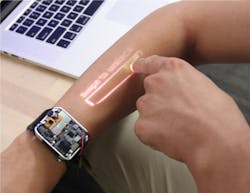LumiWatch uses picoprojector to display touchscreen on the wearer's arm (see video)
A team of researchers headed by Robert Xiao within the Human-Computer Interaction Institute at Carnegie Mellon University (Pittsburgh, PA) is developing a smartwatch with an integrated picoprojector. The system uses the skin of the wearer's arm as the surface on to which the image is projected.
RELATED ARTICLE: Virtual reality glasses from Google's Project Glass could have projected keyboard
The self-contained prototype device, named LumiWatch, also has the capability to detect the point in the projected image touched by the wearer's finger when interacting with the content in the image. The researchers believe that this approach has the potential to "expand the display area of smartwatches and provide a more intuitive form of touch interactivity."
A recent article on LumiWatch technology was presented by the team this past April at the 2018 Conference on Human Factors in Computing Systems (CHI 2018) held in Montréal, Canada. The article was entitled "LumiWatch: On-Arm Projected Graphics and Touch Input." A copy of the article is available online and can be found here.
The LumiWatch projection capability is contained in a module with a physical size of 25.8 x 16.6 x 5.2 mm. The projector outputs 15 lumens and operates in a raster-scan mode using red, green, and blue lasers. Two MEMS mirrors are used to steer the laser beams. The image is projected at 60 Hz and has a pixel resolution of 1024 x 600 and a 39 degree horizontal x 22.5 degree vertical field of view (see video):
The LumiWatch touch detection capability uses a 7 x 38 x 3 mm module containing ten STMicro VL6180X sensor elements. The sensors act as a one dimensional, time of flight, depth sensing array. The module is used to determine the wearer's 2D finger position on or near the surface of the skin when the wearer is interacting with the projected image. The result is an interactive area is about 40 square centimeters--more than five times the area found in a typical smartwatch display. The LumiWatch interactive area supports common touchscreen operations such as tapping and swiping. These capabilities enable the LumiWatch to offer touch interactions similar to that of a conventional single touch smartphone. The touch tracking frame rate of is 27.5 Hz.
Owing to the shallow angle of projection and the complex shape of the forearm surface, the researchers report that it was necessary to develop a graphics pipeline to "rectify" or correctly shape the projected image. In addition, calibration was required to enable continuous tracking of the 2D position of the wearer's finger touch on the skin. It was also necessary to perform luminance correction since pixels near to the projector are brighter than those that are further away.

Gail Overton | Senior Editor (2004-2020)
Gail has more than 30 years of engineering, marketing, product management, and editorial experience in the photonics and optical communications industry. Before joining the staff at Laser Focus World in 2004, she held many product management and product marketing roles in the fiber-optics industry, most notably at Hughes (El Segundo, CA), GTE Labs (Waltham, MA), Corning (Corning, NY), Photon Kinetics (Beaverton, OR), and Newport Corporation (Irvine, CA). During her marketing career, Gail published articles in WDM Solutions and Sensors magazine and traveled internationally to conduct product and sales training. Gail received her BS degree in physics, with an emphasis in optics, from San Diego State University in San Diego, CA in May 1986.
